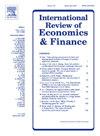Why do investors trade more following high returns?
IF 4.8
2区 经济学
Q1 BUSINESS, FINANCE
引用次数: 0
Abstract
We investigate investors’ trading behavior in response to gains and losses at the stock, style, and market levels by testing the various implications of seven trading theories. Using all U.S. stocks from July 1963 to June 2021 as a sample, we obtain several important stylized facts. First, investors trade more actively following high returns at various levels. Second, investors trade more frequently subsequent to high returns during high market-uncertainty periods than during low market-uncertainty periods. Third, investors increase their trading drastically after observing positive returns, but decrease their trading only mildly after observing negative returns. Fourth, individual investors trade more actively following positive returns than institutional investors. Fifth, investors are less motivated to trade following high returns in the recent period after the exogenous events, such as the reductions in the minimum tick size. Overall, these stylized facts are consistent with the theoretical predictions of disposition effects and overconfidence.
为什么投资者在获得高回报后交易更多?
我们通过测试七种交易理论的各种含义来调查投资者的交易行为,以应对股票,风格和市场水平的收益和损失。以1963年7月至2021年6月的所有美国股票为样本,我们得到了几个重要的程式化事实。首先,投资者在追求不同水平的高回报后,交易更加活跃。其次,在高市场不确定性时期,投资者获得高回报后的交易频率高于低市场不确定性时期。第三,投资者在观察到正收益后大幅增加交易,而在观察到负收益后仅温和减少交易。第四,个人投资者比机构投资者更积极地追逐正收益。第五,在最近一段时间内,在外部事件(如最小交易规模的减少)发生后,投资者在高回报后进行交易的动力减弱。总的来说,这些程式化的事实与性格效应和过度自信的理论预测是一致的。
本文章由计算机程序翻译,如有差异,请以英文原文为准。
求助全文
约1分钟内获得全文
求助全文
来源期刊
CiteScore
7.30
自引率
2.20%
发文量
253
期刊介绍:
The International Review of Economics & Finance (IREF) is a scholarly journal devoted to the publication of high quality theoretical and empirical articles in all areas of international economics, macroeconomics and financial economics. Contributions that facilitate the communications between the real and the financial sectors of the economy are of particular interest.

 求助内容:
求助内容: 应助结果提醒方式:
应助结果提醒方式:


